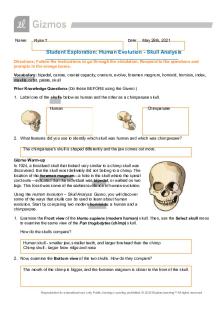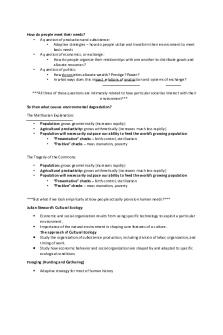Lecture 14 - Evolution of human subsistence PDF

| Title | Lecture 14 - Evolution of human subsistence |
|---|---|
| Course | Human Evolution and Diversity |
| Institution | Durham University |
| Pages | 10 |
| File Size | 360.6 KB |
| File Type | |
| Total Downloads | 67 |
| Total Views | 143 |
Summary
Lecture Notes...
Description
Evolution of human subsistence
Hunting & gathering Domestication: horticulture, agriculture & livestock Flexibility and variability compared to non-human species Subsistence strategies that support high population densities
How our diets have changed and how they compare with apes Humans are more generalised Variation in subsistence can support large population densities Comparing to great ape subsistence styles
Apes all have ‘simple’ guts, eat fruit & leaves/herbs all spend time in trees and on ground great apes do exhibit capacity for tool use prefer items of food which are digestible gorillas spend more of their time foraging on the ground – terrestrial body size is related to time spent in trees, the larger the animal the less time spent in the trees chimpanzees are semi terrestrial, they have very diverse diets cooperative hunting – a feature humans share with chimps. Both hunt as groups. Humans are the most terrestrial great ape, as we are bipedal
Pongo – spends most time in the trees where feeds on wide a variety of fruits, leaves, other plant parts - comes to ground mainly to travel longer distances between feeding areas Gorilla: most terrestrial non-human ape, and largest – eats more green genetation than others (leaves, stems etc) Chimps and bonobos both highly frugivorous, but bonobos eat more terrestrial herbs – less competition within group `all show some facility for tool use, but common chimpanzees do this most habitually – e.g. nut cracking and termite fishing Humans and chimpanzees share a particular fondness for meat – cooperative hunting likely to have been a feature of the common ancestor, as both do it – chimpanzees have had a significant effect on populations of monkeys that they hunt, and have been po Evolution of hunting Tool use used in context of hunting. There is a wide variation of fossil finds of weapons Homology refers to traits that are shared because they are from a common ancestor. Therefor these traits in humans and chimps are homologous
Hunting documented in many chimpanzee populations Chimpanzees reported to pursue ~40 different prey species (Newton-Fisher, 2015). Tai forest chimpanzees only hunt seven species, all arboreal primates. Procolobus species., especially red colobus monkeys are by far the most widely consumed animal, making up >80% of prey at Gombe, Tai and certain communities in
Kibale, and 53% of all prey at Mahale – chimpanzee predation has a significant impact on their populations Bonobos Thought to be gental and non hunting but this has not been proved wrong, as their faeces was analysed showing that they are consuming prey
Bonobos also participate in cooperative hunting Bonobos have a reputation for being gentle and peaceful. Surely they don’t hunt, right? WRONG! Faecal analysis (DNA and hair) has yielded plentiful evidence of hunting in bonobos. Early evidence indicated that bonobos ate mainly squirrels and small forest antelope (duikers). Now been observed cooperatively hunting monkeys Evidence compelling if fragmentary.
The antiquity of human hunting/meat eating using stone tools
Controversial as to when we see the first use of tools and meat eating Meat eating doesn’t necessarily involve hunting
Earliest potential evidence for hunting:
3.4 mya – the Dikika cut-marks from Ethiopia. Could have been the byproduct of taphonomic processes. 3.3 mya – The Lomekwian, from Lomekwi, Kenya – variety of stone tools, including flakes The purpose of Lomekwian lithics is yet unclear.
More evidence of tool use - Oldowan Butchery: Evidence of Hunting or Scavenging?
Oldowan lithics are not always found in contexts indicating butchery so do not necessarily indicate carnivory. May be due to other predators killing prey, then hominins scavenge meat At FLK, Zinj, Olduvai, Tanzania, Oldowan artefacts are found alongside evidence of butchery circa 1.8 mya. At Kanjara South, Kenya, compelling evidence for butchery dating to 2 mya. However, butchery does not necessarily mean hunting!
Is it scavenging? Hominins would have to have driven away the other predators from the carcass as otherwise there would probably not be a lot of meat left
ancient hominins may have scavenged meat from predators (Brain 1981). however, unless predators are actively driven away from a carcass, they usually do not leave enough meat to necessitate further de-fleshing. Currently “active scavenging” or “ambush hunting” is the favoured model, although “passive scavenging” is still difficult to discount.
First Incontestable Evidence of Weapon Assisted Hunting: Relatively Recent Associated with homo hidelbergensis
A horse shoulder blade (scapula) showing “rifling marks” from Boxgrove, England, dated to 500,000 BP (Roberts, 1998). This shows that this horse must have been injured by spears Eight Wooden Spears found perfectly preserved near the town of Schoeningen, Germany dated to between 400 – 300,000 BP.
Humans over time have increased their reliance on meat. Adaptations of humans in terms of having a high quality diet, humans are now specialized for high-quality, low fibre diets Larger the primate is the more it eats, but there is interesting variability which relates to dietary requirements Geladas – have a low quality high fibre diet, they are a terrestrial species eat blades of grass. Therefor they have to eat more as food is more low quality Changes in teeth can also reflect diet - Human teeth are smaller, and time spent eating is less, than expected for an ape of our size - again, suggests easy-to-chew, nutrient-dense diets The amount of time humans spend eating is a lot lower that other primates do, this suggests that what were eating has a higher calorie density The human gut – human guts are smaller
Human digestive proportions (relative to body size) distinct from other apes o Small total gut volume, especially stomach, caecum & colon In folivores, some or all of these are larger o Similar small intestine size Similar to other ‘faunivorous’ mammals
Do need some fibre as its good for digestion however not to much Our small intestine is similar in size to other apes, small intestine is where most protein digestion occurs Increased reliance on meat Richard Wrangham – not only eating meat was important, but the process of cooking is responsible for a lot of other aspects of evolutionary change. Cooking makes food more digestible. This is coupled with the use of fire to cook Fire use
Earliest evidence of controlled fire = baked earth at two sites Kenya 1.5 MYA and burned faunal remains at Swartkrans, SA...
Similar Free PDFs

HISTORICAL EVOLUTION OF HUMAN RIGHTS
- 18 Pages

Copy of Human Evolution SE
- 7 Pages

Human Evolution - Lecture notes 1-8
- 12 Pages

Human Cognicion Evolution
- 97 Pages

Human Evolution Gizmo - Ryan
- 8 Pages

Gizmo: Human Evolution
- 9 Pages

Evolution of HRM – Lecture 1
- 9 Pages

Modes of Subsistence
- 4 Pages

Human Evolution Final Study Guide
- 17 Pages

L7. Copyright - Subsistence
- 17 Pages
Popular Institutions
- Tinajero National High School - Annex
- Politeknik Caltex Riau
- Yokohama City University
- SGT University
- University of Al-Qadisiyah
- Divine Word College of Vigan
- Techniek College Rotterdam
- Universidade de Santiago
- Universiti Teknologi MARA Cawangan Johor Kampus Pasir Gudang
- Poltekkes Kemenkes Yogyakarta
- Baguio City National High School
- Colegio san marcos
- preparatoria uno
- Centro de Bachillerato Tecnológico Industrial y de Servicios No. 107
- Dalian Maritime University
- Quang Trung Secondary School
- Colegio Tecnológico en Informática
- Corporación Regional de Educación Superior
- Grupo CEDVA
- Dar Al Uloom University
- Centro de Estudios Preuniversitarios de la Universidad Nacional de Ingeniería
- 上智大学
- Aakash International School, Nuna Majara
- San Felipe Neri Catholic School
- Kang Chiao International School - New Taipei City
- Misamis Occidental National High School
- Institución Educativa Escuela Normal Juan Ladrilleros
- Kolehiyo ng Pantukan
- Batanes State College
- Instituto Continental
- Sekolah Menengah Kejuruan Kesehatan Kaltara (Tarakan)
- Colegio de La Inmaculada Concepcion - Cebu





